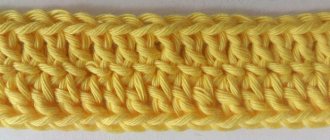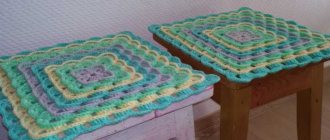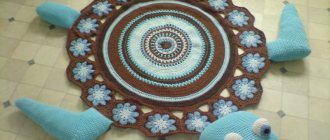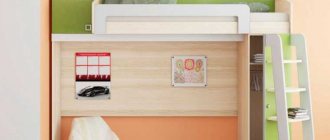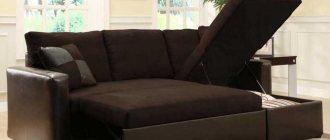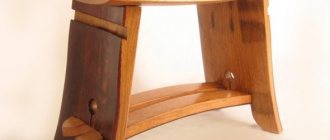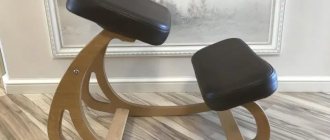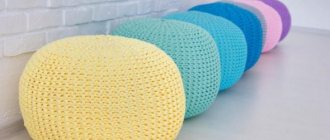Tool selection
All knitting needles vary in size and shape:
- Single straight models.
- Circular knitting needles, with fishing line.
Depending on the shape of the chosen blanket model, you should focus on the choice of knitting needles. The diameter of the knitting needle is also an indicator that depends on the thickness of the thread, the knitting method and the specifics of the pattern.
Plaid zigzag
Zigzag pattern for a blanket
The plaid strips are knitted gradually, without requiring stitching. Each strip can be knitted from a different yarn, thereby creating a special pattern. Experienced craftswomen use leftover yarn from other projects.
Zigzag pattern diagram
Description of work
Zigzag blanket knitted from 10 loops
Cast on 10 stitches and knit ten rows, always decreasing one stitch on the left and one on the right. Repeat this step, but increasing on the left and decreasing on the right. This will give you an uneven stripe that looks like lightning. The zigzags themselves can go diagonally or vertically (depending on your preference). Periodically recalculate the number of stitches on the knitting needles. There should always be the same number (in our case 10).
Beautiful zigzags are easy to knit and look beautiful
Having reached the desired length, close nine loops on the strip, one should remain on the knitting needle. Turn the future masterpiece 180 degrees and knit the next zigzag in the same way, fastening it with the previous one. After knitting another blanket using knitting needles, wash it with warm water.
Selection of materials
Today, beginners and experienced needlewomen are offered the following types of yarn:
- Wool.
- Acrylic.
- Mohair.
- Angorka.
- Linen threads.
- Alpaca.
Each of the presented models is used to create blankets of different structure, differing in the degree of softness, resistance to washing and stretching, and decorative properties.
Wool for a blanket
Natural fiber with a pleasant appearance. It features the greatest possible variety of shades, which allows you to work on creating an original design.
The thread is strong, but the finished product is not durable. After several washes, the blanket may stretch, shrink, or lose its original appearance.
In addition, it will be extremely difficult for novice needlewomen to work with this type of yarn. Baby blankets should not be knitted from pure wool yarn, as the material will scratch the baby’s delicate skin.
We recommend reading:
Knitting bactus with knitting needles - detailed description with photos and diagrams. Step-by-step instructions and recommendations from craftswomen. TOP 30 best modelsKnitting socks with knitting needles - step-by-step master class with instructions. A selection of the best knitted socks models
- Garter Stitch Knitting - 140 photos and videos of basic garter stitch patterns and projects
Knitted blankets and bedspreads in the interior
Knitted bedspreads and blankets.
A knitted blanket, regardless of whether it is hand-knitted or bought in a store, regardless of whether it serves as decoration or is used to keep the family warm, instantly transforms the interior, making it warmer, more comfortable and cozy. Before knitting or buying such a blanket, you need to know exactly who and what it will be used for.
It is unlikely that a bedspread or blanket from a nursery will be suitable for a living room or bedroom.
Why might a yarn for a bedspread in the bedroom not be suitable for a blanket in the living room and why not every blanket can be covered?
Yarn composition.
For a knitted blanket or bedspread, yarn is the main thing that determines quality and price. Wool thread
, traditionally, the most popular thread for blankets.
It can be sheep or goat wool, merino or alpaca, camel, rabbit, and finally. When choosing such a thread for knitting, we know that the product will receive a lot of useful properties
, including health benefits: with a massage effect, if the thread is prickly, it will undoubtedly be warm, “breathable,” comfortable and soft.
But it is worth knowing
that woolen blankets require careful care, do not like frequent washing, collect static, there are people intolerant to any wool, yarn and finished products have a high price.
Cotton thread
is indispensable for children's products, openwork bedspreads, and summer, lightweight versions of blankets. It does not accumulate static at all, “breathes”, is easy to wash, has a soft, pleasant structure, and never pricks. Yarn made from viscose, bamboo, and silk have the same properties (special care). Blankets and bedspreads are very light and airy.
Synthetic yarn
(acrylic, polyester, etc.) are quite suitable for knitting.
The blankets turn out soft and fluffy. Sometimes it’s hard to believe that you’re not holding a woolen item. They have a very attractive price. It is worth knowing : things made from such yarn do not “breathe” at all, become highly electrified, and quickly lose their spectacular appearance if they are used intensively. It is better not to use them for children.
Advice
: it is better to use such blankets only as decoration, for example, as a bedspread in the bedroom.
Blended yarn
- This is a compromise between price and quality. Blankets knitted from such yarn are not as scratchy as pure wool ones, and are more comfortable on the body than synthetic ones. Quality, price and comfort depend on what and in what quantity is included in the yarn, for example, acrylic mohair - the product is delicate, soft, and retains its shape well.
Caring for a knitted blanket or bedspread.
- Wash by hand.
- Delicate spin.
- Dry flat on a horizontal plane.
Dimensions
Everything here is very individual. For a bedspread, this is the size of a bed or sofa.
A narrow knitted blanket to match the main bedspread can complement the textile design of the bedroom.
The size of the blanket depends on the amount of yarn and your desire.
Patterns and types of knitting
When choosing a knitting pattern, you should be guided by your preferences and expediency. Garter stitch, openwork, braids, squares, plaits and weaves, knitting needles or crochet - it depends on the artist.
Advice:
for the fabric of the bedspread, on which they will then lie, you should choose a pattern with little relief or without it at all, since “imprints” of the pattern will be recorded on the body, and this is not very pleasant.
Blankets in the interior.
If a plaid decorates the foot of the bed in the bedroom, then skillfully knitted braids will give the interior a special charm.
Warmth and comfort is what we expect from a bedspread or blanket that we carefully knit ourselves. For a blanket in a children's room, you can choose a simple embossed or smooth pattern for the baby's comfort. In a child's room, a knitted blanket can be a beautiful bedspread, a blanket and a rug for games and activities on the floor.
Knitted with a thin thread, openwork bedspreads will become a decoration for a newborn’s room or a girl’s bedroom.
Blankets made from multi-colored squares will come in handy at the dacha or in a country house.
A blanket or blanket knitted in this way will become a bright accent in a monochrome interior.
The rough, hard, rough surfaces of brick and concrete favorably emphasize the softness and volume of a knitted blanket.
Volumetric, colorful, large-knit blankets are perfect for interiors that are kept in one color, with furniture of strict shapes, made in high-tech, minimalist styles, where there is little furniture and decor, a lot of space and light, natural materials and rough surfaces.
Advice:
Be careful when purchasing such a blanket if you have a small apartment. Its volume can fill the entire living space; opt for a small coarse knit pouf or a small chair cover.
Advice:
Since large-knit blankets are heavy and bulky and cannot be washed, a favorable habitat is created for dust mites, which explains the appearance of allergic reactions.
Scandinavian interiors are always very harmonious.
Blankets, simple knit, rustic wool in natural shades from this story.
Children and adults love bright rich colors.
Bedspreads and blankets of such colors will add a good mood to the interior of the room, and not only warm you up.
Blankets made of cashmere or alpaca wool, delicate, silky, soft, will fit perfectly into the modern interior of the living room.
Advice:
Such soft blankets can be placed on a lining. They hold their shape better and do not stretch out.
There is also a balcony, a terrace, a gazebo in the country, a picnic, cold rainy evenings and a knitted blanket.
Advice:
for the cool season, choose blankets made from warm fluffy yarn. Cotton, viscose, silk, bamboo - smooth and silky yarn - for the hot summer season.
Acrylic for knitting
A synthetic fiber characterized by a pleasant shine of the finished product. The thread is strong, glides easily along the knitting needles, even a novice craftsman can work with it. Finished products are resistant to deformation and frequent washing.
However, acrylic threads are quite cold, so only summer knitted blankets are created using them.
And here https://gidrukodeliya.ru you can visit a real club for lovers of needlework and crafts.
Blankets
Blankets and bedspreads always bring an atmosphere of comfort to your home. A knitted blanket paired with a cup of hot cocoa will definitely warm you up on a cool autumn evening. Large knitted blankets made from thick threads look very impressive.
A blanket made of multi-colored yarn in a children's room will cheer up and prevent the child from freezing. You can make something similar with your own hands from the remains of various balls. Modular knitting looks interesting, a technique essentially similar to patchwork. First, individual elements are knitted, and then crocheted or sewn together with a regular needle.
Mohair threads
This model is a combined version of yarn - natural fiber with synthetic additives. Using mohair allows you to create surprisingly warm blankets with long pile.
You should not start working with such threads, but with enough experience you can safely start knitting an original blanket. Finished blankets require special care and cleaning conditions.
Deciding on design and construction
Knitted blanket for a room in a minimalist style
In our country, needlework has always been a favorite pastime for many women, and if you dig into history, you can see that knitting is one of its most favorite types. Confirmation of this is not only knitted hats, scarves, mittens and sweaters, but tablecloths and napkins with the finest patterns, as well as warm blankets and knitted bedspreads, distinguished by their beauty and practicality.
A blanket made in a single color, which is convenient for the color composition of interior items
Among the products that you can knit with your own hands, there are several types:
- small light bedspreads;
- blankets for the chair;
- thick baby blankets;
- products made from thick yarn for sofas and beds.
Advice. When starting to knit, you need to soberly assess your skills in this matter. If a novice craftswoman takes on the job, you should not set yourself very difficult tasks, for example, knitting a bedspread for a large sofa or double bed - it may remain unfulfilled due to the difficulty of completing it. There may not be enough strength or skill here.
However, there is no reason to despair: in such a situation it is better to start with a small blanket for a crib, chair or small sofa.
Small handmade mint-colored children's blanket
The choice of the degree of complexity of the products depends on the skill of the craftswoman, but the most difficult will be making a large blanket for a sofa from thick yarn. In this case, the pattern is not even important: the knitting itself will be very heavy due to its large size and weight.
Knitted blankets are unusual: you won’t find them in every home; they can often be called masterpieces of design art
Angora for blanket
Natural soft and fluffy fiber allows you to create children's blankets with bright patterns and delicate pile.
We recommend reading:
- How to knit a turban with knitting needles - 115 photos and videos of ideas, patterns and features of knitting a turban
- Knitting bags - 155 photos and videos on how to quickly knit a stylish bag with descriptions and diagrams
- Knitting a jacket: 125 photos and video description of knitting with patterns for beginners and masters
Unfortunately, some of the fluff will be lost during use, and after washing the fluff must be tidied up to return to its original appearance.
Alpaca
This model is also a natural fiber that has a number of pleasant properties:
- The material does not cause allergies, which is important when knitting children's blankets.
- The finished product is resistant to deformation and pilling during washing.
- The blanket will be particularly durable, but at the same time, have a soft pile.
Working with yarn is very easy and quick.
Yarn used
The correct choice of material largely determines the final result. The finished product should not cause allergies and be difficult to care for . In addition, the yarn directly affects the complexity of making the bedspread, the appearance and cost of the product. As a rule, for knitting a bedspread the following is used:
- Wool. The most popular material for making a knitted bedspread. The wool used is sheep, goat, merino, alpaca, camel, and rabbit. Products made from this thread have a massage effect, provide warmth, and the bedspread “breathes.” Blankets made from this material require delicate washing using special products. Products made from natural wool are contraindicated for allergy sufferers.
- Cotton thread is suitable for making openwork bedspreads. These products are easy to wash and feel very pleasant to the touch. Threads made from viscose, bamboo and silk have similar properties.
- Synthetic thread obtained using industrial methods is also suitable for making bedspreads. Such products are particularly soft and fluffy. The material has a fairly low cost, but blankets made from such threads do not breathe, become electrified and quickly lose their appearance.
- Blended yarn is an ideal solution in terms of cost and quality ratio. Blankets of this type are more comfortable than synthetic ones, but will not itch like wool blankets.
- Thick yarn. Its main types are: knitted, velor, plush. The last two options contain 100% micropolyester (thread evenly covered with dense, soft and silky pile). Products made from such material are surprisingly delicate and cozy. The color palette of yarn is very diverse, and the knitting process itself brings a lot of pleasure. A blanket made from such a thread will be very soft and fluffy. Products made from knitted yarn have an interesting texture and are surprisingly elastic. The bedspreads are wear-resistant, and the price of the material will please you.
What material to choose for a bedspread is an individual question. Thick yarn will be good for beginners; knitting with it is easier and faster. In this case, the quality of the product will not be affected.
Blankets made from bulky thick yarn are difficult to care for and can be quite problematic to wash. If one of your family members is prone to allergies, it is better not to choose this option.
Wool
Cotton thread
Synthetic threads
Thick yarn
Mixed
Master classes on knitting a blanket
Master classes on knitting blankets are necessary for both beginners in needlework and experienced craftsmen. After all, thanks to detailed instructions and pattern formation patterns, you can decide on the knitting technique and learn the best knitting methods for beginners.
Today, there are a huge number of classic work schemes and original author’s techniques.
We recommend reading:
Knitting a cardigan: 110 photos and videos on how to quickly and easily knit a stylish and beautiful cardigan- Patterns for crocheting a tablecloth - 140 photos, descriptions of models and features of crocheting a tablecloth
- Crochet shawl patterns - step-by-step description of how to knit a shawl with your own hands
Knitting a baby blanket
To knit a warm blanket for children, it is necessary to comply not only with the color composition, but also with a number of requirements for the fiber:
- The yarn should not cause allergies or prick the baby's skin.
- The fabric should be breathable so as not to overheat the baby and allow the skin to breathe.
Natural types of yarn with a small addition of synthetic fibers have excellent characteristics (this will allow the product not to stretch after the first wash).
Detailed description of how to knit a blanket with your own hands:
- Select a drawing and download its diagram.
- If you have little experience in knitting patterns, it is worth doing a test knitting of the pattern.
- The work is best done with large knitting needles or knitting individual modules, which are then combined into a single product.
- Knitting a module: first of all, you need to cast on the required number of loops on both knitting needles.
- Release one knitting needle and then work with an English elastic band for 5-8 cm. Unlike classic elastic, this model is softer in texture.
- The pattern is knitted strictly according to the pattern.
- The end of the module is also represented by an English elastic band.
Photos of a children's knitted blanket in various modifications can be found in any magazine on practical needlework.
Patterns and descriptions of knitting a blanket
The choice of blanket models, as well as patterns and methods of knitting them, is huge. It is also worth paying attention to whether the warm blanket is knitted for adults, or for children - after all, this is also an important criterion for selecting yarn and patterns. For the little ones, blankets must be knitted according to certain rules - we will definitely tell you about them. In general, it’s an art to knit a good blanket. Let's try to understand it and consider both the easiest knitting master classes and more intricate options for knitting blankets.
Scheme for beginners
Beginning knitters should definitely start by learning the most understandable and simple options for knitting blankets. Consider a master class for beginners on knitting a blanket.
See also...
✅ How to crochet a blanket: detailed instructions
✅ How to knit a rug with knitting needles: simple and creative patterns
✅ DIY patchwork style products
✅ How I tried to knit a string bag and why it didn’t work
This blanket model is perfect for newborns or adult children. The blanket turns out pleasant, tender and soft. And knitting it with knitting needles will not be difficult because of the knitting method taken as a basis: a simple double-sided pattern of knit and purl stitches, as well as garter stitch for the edge of the product.
- What you will need
Yarn: “Svetlana” produced by “Semyonovskaya Yarn”, 250 m / 100 g, 50% wool, 50% acrylic. Yarn consumption: 350 g. Tools: circular knitting needles No. 3, knitting needle. Knitting density: main knitting Pg = 2.25 loops in 1 cm, Pv = 3.2; garter stitch Pg = 2.14 loops per cm, Pv = 4.3 rows per 1 cm.
- Calculating loops
To calculate the number of loops that need to be cast on the knitting needles for knitting a blanket, it is necessary to determine the knitting density of the main and garter stitch. Find out more about how to determine knitting density.
When calculating loops, we must take into account the desired size of the product and pattern repeat. As for the size, the standard size of a baby diaper is 80 x 80 cm, we will focus on it. We need the pattern on the blanket to be symmetrical. Therefore, you need to add loops to whole repeats for symmetry of the pattern. You also need to take into account the width of the slats along the edge of the blanket. We will knit strips 2.5 cm wide, this is 7 loops (including the edge stitch). This means that with the main knitting we need to knit 80 - 6 = 74 cm. One repeat of the main pattern is equal to 18 loops or 8 cm. For symmetry, we need to add half a repeat, i.e. 9 loops or 4 cm. It turns out that for whole repeats there are 74 - 4 = 70 cm. Let's determine the number of whole repeats: 70: 8 = 8.75, round to the nearest whole, we get 9 repeats. So, the number of loops in the main knitting :
9 (number of whole repeats) x 18 (number of loops in a repeat) + 9 (number of loops for pattern symmetry) +7 (number of loops for one strip) x 2 = 185 loops.
But we know that the knitting density (Pg) of finishing garter stitch is less than the main one. This means that so that the bar along the bottom is not too loose and does not look stretched, we need to recalculate the loops.
Let's clarify the final size of the blanket: 185 (number of loops) x 2.25 (Pg of main knitting) = 82 cm.
Now let’s determine how many loops need to be cast on the knitting needles:
82 (piece size) x 2.14 (Pg garter stitch) = 175 stitches .
- Basic pattern
Double-sided “cage” pattern of knit and purl loops with a relief texture. Pattern repeat: 18 loops wide, 24 rows long. To knit a sample pattern, cast on the knitting needles a number of loops that is a multiple of 18 plus 2 edge loops.
Diagram and description:
- classic knit stitch in the knit row, unless otherwise indicated in the pattern description. In the purl row, this is how the purl loop is indicated. - classic purl loop in the front row, unless otherwise indicated in the text. In the purl row this is how the front loop is designated.
1st, 3rd, 9th, 11th row: * knit 9, purl 9 *;
All purl (even) rows are knitted according to the pattern;
5th, 7th row: * knit 3, purl 3 *;
13th, 15th, 21st, 23rd row: * purl 9, knit 9*;
17th, 19th row: * purl 3, knit 3 *.
The pattern is repeated from the 1st to the 24th row.
- Progress
We put 175 stitches on the knitting needles using the basic method and knit 11 rows in garter stitch. We will decorate the edge a little differently than usual: we will not remove the first loop in the row, but we will knit the front one behind the back wall.
Fig. 1: The working thread is wound down and back. Fig. 2: The loop is knitted behind the back wall of the front
We knit the last loop in the row as usual, using a knit stitch.
In this case, the edge of the edge will stretch more. Considering that the horizontal knitting density (Hg) of the main knit is less than that of the finishing knit, this will allow the bar to stretch and compensate for the difference.
If the knitting densities of the main and finishing knits differ significantly, we recommend knitting the bar in shortened rows.
In the 11th row we will make straight yarn overs to add loops. We make additions evenly. We knit 11 loops (including the edge loop), make a straight yarn over, and then make yarn overs through 18 loops (pattern repeat). In total there will be 10 yarn overs along the length of the part. In the next row we move on to the main pattern. At the beginning and end of the row we knit 7 loops in garter stitch and then with the main pattern. We knit the yarn overs behind the back wall, without openwork, so that the increase is unnoticeable.
In order for the blanket to be square in height, we need to knit 11 repeats (264 rows) with the main pattern. In the last row we decrease 10 loops in the same places where we added them, knitting two loops together with a tilt to the left. We tie the bar and close the row in the classic way.
Blanket for newborn
It is a very important and responsible task to knit a blanket for a newborn. Whether it's a gift to a loved one's family or to yourself for your baby's first birthday, there are a few important things to consider when knitting the first warm blanket in a baby's life.
When choosing yarn for knitted children's items, you should pay attention to the composition: it is better to choose a yarn that contains wool with some acrylic, or merino wool, or baby alpaca with an admixture of microfiber. Be sure to make sure that the threads do not prick the skin, even if the label says that the yarn is intended for knitting children's clothes.
Let's try to knit another easy-to-make blanket that a beginner can make. And they will help you knit a blanket for a newborn with knitting patterns and a detailed description.
- Knitted blanket for newborns
Knitting density: 14 loops * 21 rows = 10 * 10 cm.
Size: 89x96.5 cm.
- What you will need
Yarn: 4 skeins of RedHeartSoftBabySteps yarn (100% acrylic, 142 g/234 m).
Tools: 5.0 mm circular knitting needles. more than 90 cm long.
- How to knit a blanket
How to knit 2 knits together. to the left: insert the right knitting needle into the first, then into the second loop of the left knitting needle, knit these two loops together.
How to knit 2 knits together. to the right: insert the right knitting needle into the second, then into the first loop of the left knitting needle, knit these two loops together with the front one behind the front wall.
- Main job
Cast on 121 stitches on the needles.
- 1st row (front side): k8, (p7, k7) – 8 times, k1.
- 2nd row : 8 purl, (7 knits, 7 purl) – 8 times, 1 purl.
- 3rd row: k4, yarn over, k2tog. to the right, knit 2, (p3, yarn over, purl 2 together, purl 2, knit 3, yarn over, knit 2 together to the right, knit 2) – 8 times, knit 1.
- 4th row: repeat 2nd row.
- 5th row: k2, k2 together. right, yarn over, knit 1, yarn over, knit 2 together, right, knit 1, (p1, purl 2 together, yarn over, purl 1, yarn over, purl 2 together, purl 1, knit 1. , 2 knit together to the right, yo, 1 knit, yo, 2 knit together to the right, 1 knit) – 8 times, 1 knit.
- 6th row: repeat 2nd row.
- Row 7: K3, k2tog. to the right, yarn over, knit 3, (p2, purl 2 together, yarn over, purl 3, knit 2, knit 2 together, yarn over, knit 3) – 8 times, knit 1.
- 8th row: repeat 2nd row.
- Repeat rows 2-8 - 18 times.
- Last row: k8, (p7, k7) – 8 times, k1.
Close the loops.
- Diagram and designations:
- Plaid finishing
1st row (right side): *(pick up 6 knit stitches along pattern square) – 19 times, (pick up 6 stitches along pattern square) – 16 times, pick up 5 stitches along next pattern square, repeat from * = 430 loops on the knitting needles.
Place a marker.
Start knitting in the round.
2nd row: purl. loops.
3rd row: k1, *knit 5 stitches in the next row. loop, turn, purl 5, remove trace. loop, turn, k2 together. to the right, {(slip the outer loop from the right knitting needle to the left one, knit 1) – 2 times, knit 1, throw the previous loop of the right knitting needle over the last knitted one} – 3 times, (slip the outer loop from the right knitting needle to the left one, knit 1 .) – 2 times, 2 persons together. to the right, throw the previous loop of the right needle over the last knitted one, bind off 3 loops, repeat from *
Close all loops. Hide the ends of the threads.
How to knit a baby blanket
Older children will find it more interesting to cover themselves with a bright, unusual blanket. Therefore, you need to base your choice on whether a blanket is knitted for a boy or a girl. We offer to make a blanket in interesting colors and voluminous relief motifs, which the girl will definitely like.
This blanket model has many interesting elements, patterns and motifs - making it fun for experienced knitters to knit. Braids, mesh, leaves, Aran weaves - the blanket will be very rich in different patterns. And although adults wouldn’t refuse such a thing, we’ll still knit a children’s blanket with knitting needles.
- What you will need
Yarn: 8 skeins of Zealana Kiwi Lace Weight (40% merino wool, 30% cotton, 30% possum wool, 199m/40g);
Tools: Circular knitting needles No. 3.5; 2 auxiliary knitting needles; 6 markers.
Knitting density, sequence of patterns: 27 sts and 30 r. = 10 x 10 cm
Children's blanket knitted - diagram, description
- Patterns:
Right edge: knit according to pattern 1 from the 1st to the 10th row.
Inner part: knit according to pattern 2 from the 1st to the 20th row.
Central part: knit according to pattern 3 from the 1st to the 20th row.
Left edge: knit according to pattern 4 from the 1st to the 10th row.
Mesh: knit 8 stitches according to pattern 5:
Each r.: 3 knits, yo, 2 sts together purl, yo, 2 sts together purl, 1 knit.
- Formation of folds
First half of the fold: transfer 10 sts to the first knitting needle, transfer the next 10 sts to the next knitting needles (5 purl, knit 5). Hold all three knitting needles on the wrong side of the knitting. Place the knitting needles opposite each other, folding to form a fold, and knit 3 sts together. To perform 3 stitches together. Insert the end of the right knitting needle into the first st of the first knitting needle, then into the first st of the second knitting needle and into the first st of the third knitting needle and knit 3 sts together. Repeat 9 more times.
Second half of the fold: transfer 10 stitches to the first knitting needle and place on the right side of the knitting. Transfer the next 10 stitches (knit 5, purl 5) to the next needles. Place the knitting needles opposite each other, folding to form a fold, and knit 3 sts together. To perform 3 stitches together. Insert the end of the right knitting needle into the first st of the first knitting needle, then into the first st of the second knitting needle and into the first st of the third knitting needle and knit 3 sts together. Repeat 9 more times.
Cross 7 sts to the right: leave 4 sts as auxiliary. knitting needle at work, k3, then knit with aux. knitting needles 1 p. and 3 p. persons.
Cross 7 sts to the left: leave 4 sts as auxiliary. knitting needle before work, k3, then knit with aux. knitting needles 1 p. and 3 p. persons.
- Description of knitting
Cast on 547 stitches on the knitting needles and knit the border as follows:
1st r.: persons.
Row 2: k1, p2 together. behind the back wall, yarn over, knit 270, knit 2 stitches together, knit the last 3 stitches, yarn over, knit 2 stitches together, knit 1. = 546 p.
Row 3: k3, p15, k30, *p30, k30*, repeat from * to *, knit last 18 sts, p15, k3.
Row 4: k1, p2tog. for the back half-loop, yo, k15, p30, *k30, p30*, repeat from * to *, knit the last 18 sts. K15, yo, 2 sts together purl, k1 .
Repeat the last 2 r. 9 times = 22 rub. edges.
- Making folds
23rd row: k3, make 9 folds, k3. = 186 p.
Row 24: k1, p2tog. behind the back wall, yarn over, knit 17. (2 stitches together, knit 16) 8 times, 2 stitches together, knit 17, yarn over, 2 stitches together, knit 1. = 177 p.
25th day: persons.
Row 26: k1, p2 together. behind the back wall of the p., yarn over, knit 14, place a marker, knit 33, place a marker, knit 8, place a marker, knit 61, place a marker, knit 8, place a marker, knit 33, place a marker, K14, yarn over, 2 stitches together, knit 1.
- The main detail and sequence of patterns
1st r.: 17 sts of the right edge according to pattern 1, place a marker from the left knitting needle to the right, 33 sts of the inside according to pattern 2, place a marker from the left knitting needle to the right, 8 mesh sts, place a marker from the left knitting needle on the right, 61 sts of the central part according to pattern 3, place a marker from the left knitting needle on the right, 8 sts of the mesh, place a marker from the left knitting needle to the right, 33 sts of the inner part according to pattern 2, place a marker from the left knitting needle to the right one, 17 sts of the left edge according to pattern 4.
Continue knitting according to the patterns until RUR 438. (repeat 18 rows of the central and inner parts 21 times, repeat 8 rows of the left and right edges 43 times).
439th r .: complete the 9th r. right edge, place a marker from the left needle to the right, p1, k12, 7 stitches cross to the left, k12, p1, place a marker from the left needle to the right, 8 stitches, place a marker on the left knitting needles on the right, 19th row. central part, place a marker from the left needle to the right, 8 stitches of the mesh, place a marker from the left needle to the right, p1, k12, 7 stitches cross to the left, k12, p1, place a marker on the left knitting needles on the right, 9th row. left edge.
440th row: bind off 4 sts, purl 2 sts together. behind the back wall, yarn over, knit. to the last 3 sts, yarn over, 2 sts together purl, k1. = 177 p.
Finishing: Soak for a few minutes in warm water or wash according to yarn instructions, gently wring in a clean towel to remove excess moisture, lay out and stretch to appropriate sizes until dry.
Plaid of squares
The patchwork style is also successfully used in knitting - for this, pre-knitted motifs with different patterns are sewn or knitted into a single product. This knitting method is very popular, so you should definitely try knitting a blanket from squares with knitting needles. This is not difficult to do.
There are quite a lot of options for knitting a blanket of this type, as well as design solutions that can be used to “revive” it: make traditional squares of all possible colors, or choose just a few harmonious shades of yarn for the blanket. Some knit blankets from squares in a single color, focusing only on the variety of patterns of connected motifs. The squares themselves can be flat, or they can be decorated with convex elements, which will also add patchwork charm to the finished product.
We have selected an “advanced” version of knitting a blanket in squares so that it would be interesting for experienced knitters as well. It will take a little more time and effort, but the result is definitely worth it.
- What you will need
Yarn (100% cotton; 120 m/50 g) – 200 g each of mustard yellow, light brown, color. cinnamon and hot pink, as well as 150 g each of light green and color. fuchsia.
Tools: stocking needles No. 4; circular knitting needles No. 4, 60 cm long; hook No. 3.5.
- Plaid with knitting needles - diagram and description of the work progress
Size: 110 x 132 cm.
Pattern “Square with leaves”
Cast on 12 loops on the knitting needles, distribute the loops on 4 knitting needles (= 3 stitches on each knitting needle), close them in a ring and knit according to pattern 1. It shows odd circular rows. In even circular rows, knit loops according to the pattern or as indicated, and also knit yarn overs as indicated.
The diagram shows 1 repeat = ¼ square, which should be knitted a total of 4 times (there is always 1 repeat on 1 knitting needle), and increase as indicated. If necessary, switch to circular knitting needles.
1–38th circle.r. perform 1 time, then close all 164 stitches with facial stitches.
Multicolored square
Cast on 8 loops on the knitting needles, distribute the loops on 4 knitting needles (= 2 stitches on each knitting needle), close them in a ring and knit according to pattern 2.
The diagram shows all the circular rows and 1 repeat = ¼ square, which should be knitted a total of 4 times (there is always 1 repeat on 1 knitting needle), and increase as indicated. The color of the thread is indicated in the text next to the number of the circular row. If necessary, switch to circular knitting needles.
1st–40th circle.r. perform 1 time, then bind off all 164 sts of the row with the knit thread of the last color.
- Knitting density
41 p. x 36 round. square with “leaves” = 22 x 11 cm; 41 p. x 40 round. multi-colored square = 22 x 11 cm; each square – approx. 22 x 22 cm.
- Square layout plan
- Progress
Knit 16 squares with “leaves”, of which 3 squares are bright pink, mustard yellow and color. cinnamon, as well as 2 squares each of light green and light brown.
Knit 15 multi-colored squares in accordance with the color data of the thread A-E next to the number of the circular row as follows:
Square B1 (2 parts): A = light brown thread, B = color thread. fuchsia, C = light green thread, D = color thread. cinnamon, E = mustard yellow thread.
Square B2 (3 parts): A = light green thread, B = color thread. cinnamon, C = mustard yellow thread, D = light brown thread, E = hot pink thread.
Square B3 (3 parts): A = bright pink thread, B = color thread. cinnamon, C = mustard yellow thread, D = light green thread, E = light brown thread.
Square B4 (3 parts): A = light brown thread, B = mustard yellow thread, C = color thread. cinnamon, D = hot pink thread, E = color thread. fuchsia.
Square B5 (4 parts): A = color thread. fuchsia, B = hot pink thread, C = light green thread, D = mustard yellow thread, E = color thread. cinnamon.
Square B6 (2 parts): A = mustard yellow thread, B = light brown thread, C = light green thread, D = color thread. fuchsia, E = thread color. cinnamon.
- Assembly
Place the squares according to the layout plan and sew them on the wrong side of the work.
From thick yarn
The fashion for blankets made from thick yarn never goes away, and if you haven’t tried knitting very warm and cozy blankets, then it’s time to do it right now! If you knit a blanket with knitting needles from thick yarn, it is guaranteed that the most favorite thing for each family member will appear in the house, because a feeling of warmth will come even from its mere appearance! A blanket made from thick yarn looks airy and interesting, and it works even for the most simple ornaments.
- What you will need
Yarn: 4 skeins of RED HEART Comfort Chunky yarn (100% acrylic, 360 g/410 m).
Tools: 15.0 mm circular knitting needles. 80 cm long.
- Thick yarn blanket
Size: 124 x 140 cm.
Knitting density: 8 loops * 10 rows = 10 * 10 cm with thread in two folds in a pattern.
- Scheme and description of the pattern
Braid 3x3 to the right: slip the first 3 stitches onto an additional needle, place them together with the additional needle behind the work, knit 3 knits from the left needle, then knit 3 knits from the additional knitting needle.
Braid 3x3 to the left: slip the first 3 stitches onto an additional needle, place them together with the additional needle before working, knit 3 from the left needle, then knit 3 from the additional needle.
- Scheme and progress of work
Using double yarn, cast on 98 stitches.
1st row (front side): k12, p2, *k6, p2, repeat from * to last 12 stitches, k12.
2nd and all purl rows (wrong side): k6, p6, *k2, p6, repeat from * to last 6 stitches, k6.
3rd row: repeat 1st row.
5th row: k6, braid 3*3 to the right, *p2, k6, p2, braid 3*3 to the right, repeat from * to the last 6 loops, k6.
7th row: knit as 1st row.
9th row: knit as 1st row.
11th row: k12, *p2, braid 3*3 to the left, p2, k6, repeat from * to the last 6 loops, k6.
13th row: knit as 1st row.
15th row: knit as 1st row.
16th row: knit as 2nd row.
Repeat rows 5-16 for the pattern until the height is 140 cm.
Finish the 9th or 15th row .
Close all loops. Hide the ends.
Modular blanket made of squares
The main feature of this model is the ability to create it from the remains of multi-colored yarn. The finished product takes on an original look that fits perfectly with the high-tech and Provence style of the room's interior.
To work, you need to prepare straight knitting needles, yarn and, if desired, a pattern. Step-by-step instruction:
- Measure the dimensions of the square module.
- Depending on the size of the module, cast on the required number of loops on the knitting needles.
- Release one knitting needle and knit a square according to the chessboard principle: alternating purl and knit stitches 2*2, different in each row.
After creating all the modules, they should be connected with a knitting needle into a single product. Using a hook, you can create an original border along the edges of the blanket.
Sectional patterns
The lightest of all types is a plaid with sectional patterns. A common variation is "grain".
Scheme of a simple pattern “Grain”
This practical blanket is knitted from several colors of yarn in a simple pattern.
Before creating it, mentally mark your plaid into equal sections, measuring 20 by 20 loops. Alternate the squares in a checkerboard pattern using purl and knit stitches until a pattern is formed.
Scheme of a simple pattern “Chess”
To knit such a blanket using knitting needles you do not need to be an experienced craftswoman. If desired, you can make multi-colored sections using uniform knitting. There are no restrictions on the size of the squares, change them as you wish.
Even a novice knitter can knit a beautiful children's blanket with a checkerboard pattern.
To choose the correct size, cast on twenty loops and measure them with a ruler. Divide the desired length and width by the resulting number. This is how you calculate how many stitches you need to cast on in the first row.
Calculation of loops for knitting
Knitting Canadian elastic
The technique is based on the creation of an openwork motif and relief patterns on the canvas. Before starting work, it is worth creating a ready-made scheme for forming the ornament, deciding on the color composition and size of the blanket.
For beginning craftsmen, the modular principle of operation or the use of circular knitting needles, which allow knitting large items, is best suited.
Combed ribbon blanket
Very often, such soft and stylish blankets are knitted by hand without using tools, but using large knitting needles you can also successfully knit a blanket. Advantages for beginner needlewomen:
- Easy working technique.
- A huge selection of instructions, diagrams and educational video lessons.
- Stylish design and bright colors of wool yarn.
However, care should be taken when working with combed tape as the material can tear easily.
Plaid with zig-zag pattern
This pattern for the ornament is one of the simplest. To create an original and beautiful blanket, you should use the instructions:
- Determine the expected width of the blanket.
- Cast on the required number of stitches on the knitting needles.
- Knit the first 5-6 cm with an English elastic band.
- The next two rows of fabric should be garter stitch.
- A zigzag pattern is made with threads of a different color.
- Pattern for the ornament: edge loop, 1 sheet. p., yarn over, 6 l. p., 3 loops knit together, 6 l. n. Repeat until the end of the row, finish 1 l. p., 1 edge loop.
- In the second row, all yarn overs are knitted with purl stitches.
The pattern of the ornament is repeated until the end of the entire blanket, and the last 5-6 cm are knitted with an English elastic band.
Photo of a blanket with knitting needles
Did you like the article?
2+

